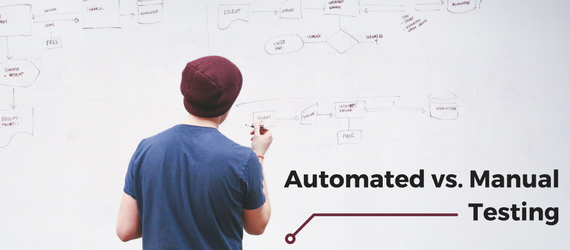Automated testing is a test method in which automated tools perform tests that execute predefined testing scenarios, comparing the expected results of the developed product with the results obtained.
If the testing scenario is executed properly, without any error, the test is considered to have been carried out successfully. If not, the results need to be analyzed.
Automated tests have to be adapted to the technical configuration of the digital product: the automatization process thus requires significant time spent on writing the scripts and the initial scenarios upfront.
In an agile environment, where changes to the product are recurring, it means that the test scripts must be maintained regularly. Every change carried out on the automated path, whether it is graphical, functional or technical, can have an impact on the scripts.
What is manual testing?
Manual testing, as its name indicates, is done manually by testers who use and test the digital product in the same way as the end users. The tests can be done according to two different methodologies: with a scenario or in an exploratory manner.
When the preferred methodology is scenarized, testers follow predefined paths to control specific aspects of the digital product. Exploratory testing, however, focuses on investigating the digital product without set requirements.
Read our article: 5 best practices of exploratory testing
Do organizations have to choose one or the other?
A digital product like a website or app can be tested manually or through automation, which makes it possible use both approaches. Nonetheless, the choice will depend on several criteria related to the project, the digital product itself and to organizational constraints (budget, resources available ...).
In general, organizations can choose to automate the most frequent test cases, the most critical ones, the ones that are the least subject to modification or those that have predictable results or that are easy to automate, allowing for a high return on investment. For example, an organization can automate tests that are carried out through the sales funnel of an e-commerce site, so that they can be performed frequently.
However, even for organizations that succeed in automating most of their testing tasks, manual testing still has a crucial role to play.
It is actually impossible for an organization that is developing a digital product with high business and brand image potential at stake, to completely automate the tests they want to carry out. This is especially true if the environment is agile or if the script maintenance is a heavy task.
Thanks to the knowledge and the judgment of the testers, manual testing makes it possible to ensure that the digital product is of a high-quality level, as expected by the end users. This method also allows to cover certain types of tests and scenarios which would otherwise be impossible to carry out with an automated test strategy and therefore to address the following points:
Example: Is the design legible?
Examples: Is it easy to access the desired functionality by tapping with a finger? Does the captcha work? What happens when an application is used on mobile and there is an incoming call?
Examples: How does the product function under certain conditions, such as a low battery level or low memory?
Example: Is the translation in the target language and other location data (currency etc.) adequate for the geographical area targeted?
For organizations that integrate automatization, manual testing will thus complement the process. Testers will focus on high added value tests and those that require a high technicity (for example: multiple management rules, complex cases, conditional forms…).
Manual and automated tests do not cannibalize each other but rather work together following a complementary logic. Each approach answers a precise organizational requirement and need at a specific time. The optimal strategy is to mix both approaches in order to reach the optimum test coverage and budget efficiency.
To learn more about automated testing, please do not hesitate to download our automated testing guide below.





